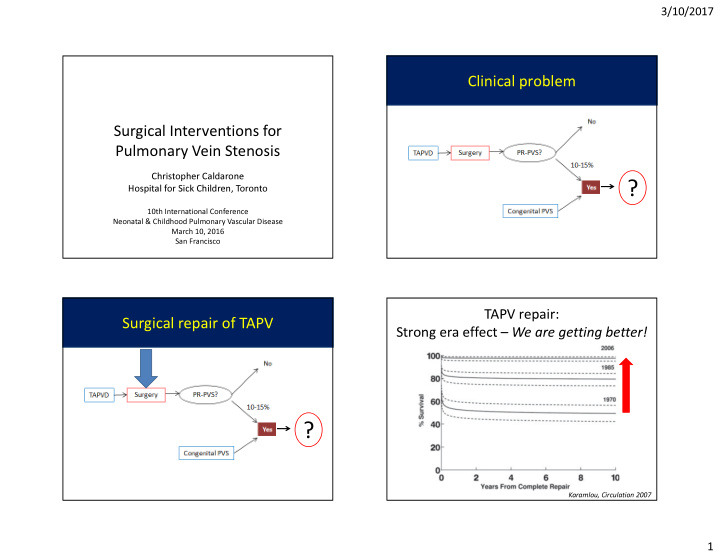



3/10/2017 Clinical problem Surgical Interventions for Pulmonary Vein Stenosis Christopher Caldarone Hospital for Sick Children, Toronto ? 10th International Conference Neonatal & Childhood Pulmonary Vascular Disease March 10, 2016 San Francisco TAPV repair: Surgical repair of TAPV Strong era effect – We are getting better! ? Karamlou, Circulation 2007 1
3/10/2017 TAPV repair: TAPV repair: Still a problem in ‘unfavorable patients’ Early hazard phase for reoperation Karamlou, Circulation 2007 Karamlou, Circulation 2007 TAPV repair: Residual stenosis predicts reop Risk Factors for Reoperation % Freedom From Reoperation Unobstructed High risk population Small PV confluence Mixed type Small patients (<2 kg) Right atrial isomerism Postop obstruction Years From Complete Repair Yun, JTCVS 2005 Karamlou, Circulation 2007 2
3/10/2017 Diagnosis: Post-repair Pulmonary Vein Stenosis Post-repair pulmonary vein stenosis Three varieties • Anastomotic stenosis • Fibrosis of confluence • Retrograde ‘UPSTREAM’ progression into lungs – Unilateral or bilateral ? – Often relentless Surgical evaluation: Who is operable? Post-repair pulmonary vein stenosis ? 3
3/10/2017 Extent of disease can predict survival: PVS Score PVS Score • Grading of PVS in each pulmonary vein 0: None 1: Mild-Moderate 2: Severe 3: Occlusion P<0.0001 • Summation of PVS grades of 4 PVs • Possible range: 0 - 12 Yun, JTCVS 2005 Yun, JTCVS 2005 ‘Upstream’ pulmonary veins ‘Upstream’ pulmonary veins (Not here) Operate HERE! Use a clinical surveillance protocol to detect recurrence early! 1, 6, 12 months (at least) LoRito, JTCVS 2016 LoRito, JTCVS 2016 4
3/10/2017 Congenital PVS Congenital PVS ? Viola, JTCVS 2011 Surgical treatment for PR-PVS: PR-PVS and congenital PVS Sutureless repairs ? 5 year survival ~55% Quinonez, JTCVS, 2015 5
3/10/2017 John Coles’ Hypothesis John Coles’ Hypothesis Irregular contour >> geometric distortion which is • ‘Sutureless repair’ ‘fixed’ by a sutureline • Atrium to pericardium – No direct anastomotic suture Distortion – “Controlled bleed” into neoatrium Upstream • No geometric constraints on tissue propagation >>> Tissue conforms to local flow patterns Flow Local disturbance injury Sutureless Repairs: A Controlled Bleed Courtesy: Nicola Viola 6
3/10/2017 Post-repair PVS Post-repair PVS Yun, JTCVS 2005 Devaney, Ann Thor Surg 2006 Mixed TAPVD If beneficial for PR-PVS, should we use sutureless repairs for all TAPV patients? > Prophylactic procedure Simplifies complex geometry Honjo, Ann Thor Surg 2010 7
3/10/2017 Primary sutureless repair for TAPV Primary sutureless repair for TAPV Konstantinov 2004 Konstantinov 2004 Primary sutureless repair for TAPV Primary sutureless repair for TAPV Positive Attributes: Negative Attributes: Less precision required Broncho-atrial fistula? >> EASY Pleural disruption? Short learning curve Easier to teach Embolism? No circulatory arrest >>> Uncommon Konstantinov 2004 Konstantinov 2004 8
3/10/2017 Primary sutureless repair for TAPV Primary sutureless repair for TAPV Can we prove there is a benefit? • Shi et al • n=768 Sample size requirement • Lower restenosis in patients with preop PVS – Assume 50% decrease PR-PVS – 150 patients (10 years of accrual) needed � High risk populations >> smaller sample size � Registry (e.g. PVS Network) will enable � Low risk of adverse events makes it attractive Yun, JTCVS 2005 Shi, Circulation 2017 Surgical treatment for PR-PVS: Conclusions: Sutureless repairs Lung transplant • Sutureless repairs for treatment of post-repair pulmonary vein stenosis >> ‘superior’ midterm results • Sutureless repairs for prevention of PVS – Less clearly supported, but little downside ? – Recommended for: • patients at high risk of recurrence • mixed TAPV 9
3/10/2017 Lung transplant and PVS Lung transplant and PVS 5 year survival: 60% BO-free survival ~50% Preop ECMO is risk factor* • 12 congenital PVS + 8 acquired PVS • Median wait: 26d • Bilateral lung transplants on CPB J HeartLungTransplant2013;32:621–625 J HeartLungTransplant2013;32:621–625 Dual lumen ECMO catheter Waiting for transplant RA > LA • Mechanical Pulmonary Support – ECMO • Rapidly evolving techniques – RA>LA (pump + oxygenator, special cannula) – PA>LA (oxygenator) Javidfar JTCVS 2012 10
3/10/2017 Paracorporeal lung assist device (PLAD) Paracorporeal lung assist device (PLAD) PA > LA PA > LA • Stabilize awaiting transplant • Enable therapies in non-hypertensive lungs • Enable surgical interventions Sweet, JTCVS 2014, Gazit Pediat Transplant 2016 Conclusion • Surgery is not enough • Immediately achievable: – Match surveillance to velocity of disease • Detect while still treatable • Use Clinical Surveillance Protocol (1,6,12 months) • Use dedicated ‘PVS Team’ to manage surveillance and treatment • Our future – Combination therapy offers opportunities • Integrate catheter-based <> surgical interventions • Mechanical pulmonary support <> transplant <> MPS-enabled therapies • Medical adjuncts (losartan, gleevec, avastin) 11
Recommend
More recommend